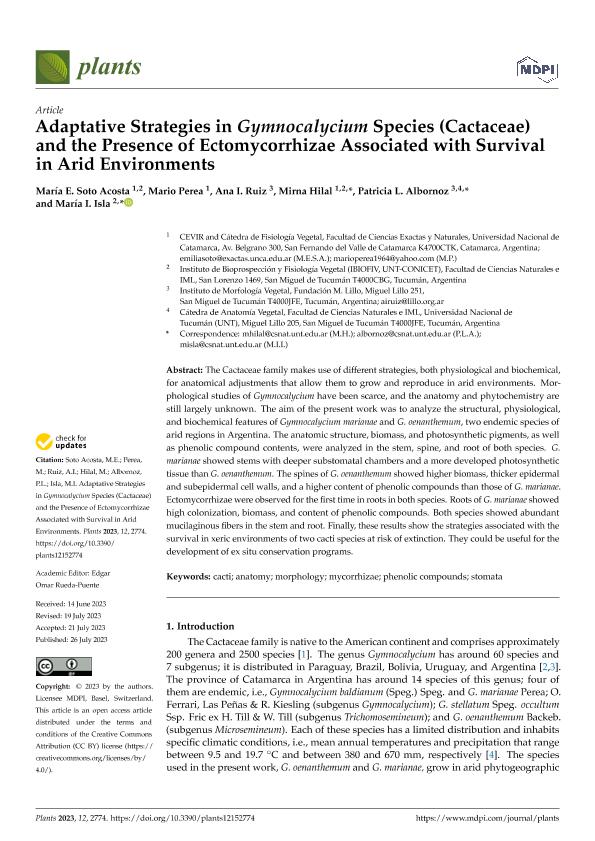Artículo
Adaptative Strategies in Gymnocalycium Species (Cactaceae) and the Presence of Ectomycorrhizae Associated with Survival in Arid Environments
Soto Acosta, Maria Emilia ; Perea, Mario; Ruiz, Ana I.; Hilal, Mirna Beatriz; Albornoz, Patricia Liliana; Isla, Maria Ines
; Perea, Mario; Ruiz, Ana I.; Hilal, Mirna Beatriz; Albornoz, Patricia Liliana; Isla, Maria Ines
 ; Perea, Mario; Ruiz, Ana I.; Hilal, Mirna Beatriz; Albornoz, Patricia Liliana; Isla, Maria Ines
; Perea, Mario; Ruiz, Ana I.; Hilal, Mirna Beatriz; Albornoz, Patricia Liliana; Isla, Maria Ines
Fecha de publicación:
08/2023
Editorial:
Multidisciplinary Digital Publishing Institute
Revista:
Plants
ISSN:
2223-7747
Idioma:
Inglés
Tipo de recurso:
Artículo publicado
Clasificación temática:
Resumen
The Cactaceae family makes use of different strategies, both physiological and biochemical, for anatomical adjustments that allow them to grow and reproduce in arid environments. Morphological studies of Gymnocalycium have been scarce, and the anatomy and phytochemistry are still largely unknown. The aim of the present work was to analyze the structural, physiological, and biochemical features of Gymnocalycium marianae and G. oenanthemum, two endemic species of arid regions in Argentina. The anatomic structure, biomass, and photosynthetic pigments, as well as phenolic compound contents, were analyzed in the stem, spine, and root of both species. G. marianae showed stems with deeper substomatal chambers and a more developed photosynthetic tissue than G. oenanthemum. The spines of G. oenanthemum showed higher biomass, thicker epidermal and subepidermal cell walls, and a higher content of phenolic compounds than those of G. marianae. Ectomycorrhizae were observed for the first time in roots in both species. Roots of G. marianae showed high colonization, biomass, and content of phenolic compounds. Both species showed abundant mucilaginous fibers in the stem and root. Finally, these results show the strategies associated with the survival in xeric environments of two cacti species at risk of extinction. They could be useful for the development of ex situ conservation programs.
Palabras clave:
ANATOMY
,
CACTI
,
MORPHOLOGY
,
MYCORRHIZAE
,
PHENOLIC COMPOUNDS
,
STOMATA
Archivos asociados
Licencia
Identificadores
Colecciones
Citación
Soto Acosta, Maria Emilia; Perea, Mario; Ruiz, Ana I.; Hilal, Mirna Beatriz; Albornoz, Patricia Liliana; et al.; Adaptative Strategies in Gymnocalycium Species (Cactaceae) and the Presence of Ectomycorrhizae Associated with Survival in Arid Environments; Multidisciplinary Digital Publishing Institute; Plants; 12; 15; 8-2023; 1-14
Compartir
Altmétricas



